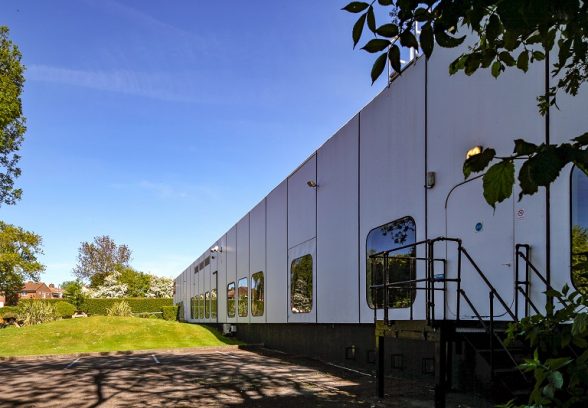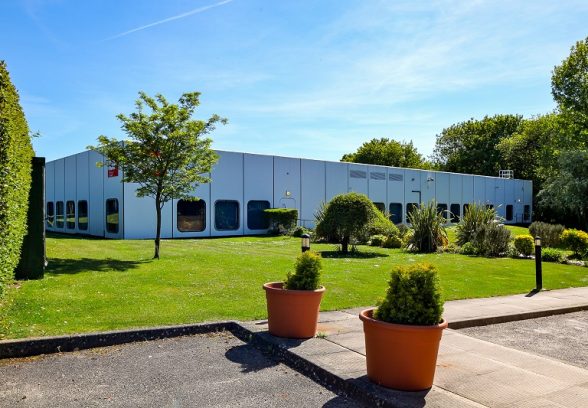This website uses cookies
This website uses cookies to enable it to function properly and to analyse how the website is used. Please click 'Close' to accept and continue using the website.




June 2017 - UOP Fragrance Factory, Surrey
by August Myrseth
The UOP Fragrance Factory was designed in 1969 by Richard Rogers and Renzo Piano as a purpose-built perfume laboratory and manufacturing site for Universal Oil Products. It was completed in 1973, and production began at the site in early 1974. The factory is currently under threat of complete demolition.
This one-storey factory lies low in the landscape on a trading estate in Tadworth, Surrey, a discreetly situated, human-scale building. Its original bright yellow must have been a striking sight – perhaps to some an eyesore – peeking out from the lush greenery separating the estate from the well-kept streetscape of suburban Surrey.
The pioneering design of the factory is probably underappreciated: it incorporates a range of features and ideas that were later to define the High-tech movement. Based on Richard Rogers’ signature Zip-Up principles, the building is clad in uniform, large panels in Glass Reinforced Concrete (GRC), that could in theory be repurposed and rescaled with the addition or removal of panels. However, this flexibility was never used, remaining a theoretical possibility. Many of the panels have large rounded square glass windows, allowing natural light to supplement the artificial lighting of the interior.
Four structurally identical parts make up the factory; administration; laboratory; production and stores. All compartments have minimal fixtures to allow for flexibility and later repurposing. The compartments are separated by simple plate glass walls, allowing for a spacious atmosphere, easier communication between compartments, and greater energy efficiency. The boxy form of the factory, the minimal internal fixtures, and the original bright yellow paint candidly reference Rogers’ earlier Zip-up House design from 1967 that nobody ever dared build.
The building’s technological prowess is rather elusive compared to Piano & Rogers Pompidou Centre in Paris, where most piping and technical features form part of the exterior for the world to see. At a time when metallic cladding was not yet fully developed, GRC was a sturdy and economic alternative. Given that the UOP Perfume Factory was completed in 1973-1974, it is likely that it predates 22 Cannon Street as the first building in the world completely clad in GRC.
A strong emphasis was placed on creating a nice workplace beyond just a manufacturing site. The project’s commitment to employee welfare is reflected in the spacious rooms, sleek furniture and bright, pastel colours. The separation of the different compartments by glass walls optimised communication between the departments, creating a single, integrated workspace – signalling a final departure from the strict division between administration and labour in industrial sites or earlier times, and providing a template for industrial workspace in a new technological age.
The building went on to win the RIBA Regional Award Commendation and the British Steel Corporation Structural Steel Design Award in 1975, but was soon eclipsed by the duo’s Pompidou Centre in Paris and the success and influence of their later works.
Despite its later drift into obscurity, the building was given broad coverage by the influential architectural journals. “The solution arrived at signals a much-pleasing modesty both in design and scale on the outside” wrote MD of the building’s sensitivity to its surroundings. Despite its plain exterior, Architectural Review’s Andrew Rabeneck characterised the building as “by the canons of recent similar examples, an inside-out building. Instead of the immaculate glass exterior and solid partitions, it has opted for the reverse.” The coverage and the high profile made a lasting impression and influenced industrial buildings of the later 1970’s, such as the Grade II listed Herman Miller Factory in Bath.
Today, the building is under threat of complete demolition. Deprived of its original yellow colour and long since sold by the original client, the building is still far from derelict. Structurally intact and in new ownership, its flexibility for new uses has already been proven.
The emphasis Rogers and Piano put on employee welfare, technical innovation, structural flexibility and sound economics reflect an exciting time in British industrial architecture, and values that were to define the later, more celebrated works of these two architects. This pioneering factory building is highly significant both in its own right and as an early work of an architectural partnership recognised for its significance in the hi-tech movement. The UOP Fragrance Factory is far too good for demolition.
August Myrseth is a volunteer for the C20 Society
Look for past Buildings of the Month by entering the name of an individual building or architect or browsing the drop down list.

Become a C20 member today and help save our modern design heritage.